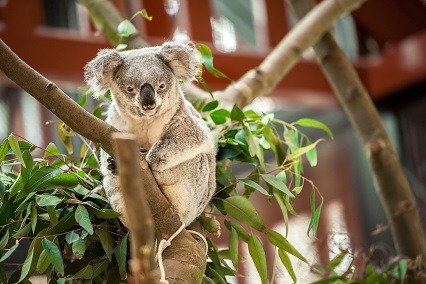A leading Belgian zoo is contributing to protecting a newly endangered species… and cutting its carbon footprint at the same time. Antwerp Zoo has become only the tenth in the whole of Europe, and the second in Belgium, to keep koala bears.
The new home for the two gentle marsupials, who are called Goonawarra and Guwara, is the newly restored Flemish Garden at the zoo.
The two animals are former residents of Planckendael where they proved to be a good breeding couple. The couple’s offspring, Oobi Ooobi, born in 2014, remains in Planckendael but is now old enough to stand on his own feet and may soon be able to join his parents in their Antwerp residence.
Planckendael was,until now, the only Belgian zoo with koalas among its residents.
Antwerp zoo is closely involved in an international breeding programme and a spokesman said, “Koalas are anything but easy guests. They are shy, sensitive to stress and fussy eaters. Koalas eat only eucalyptus and they only like 100 out of the 800 species. Eucalyptus contains a lot of fibre and substances that are toxic to other animals.
“Antwerp and Planckendael, however, grow their own eucalyptus and, therefore, reduce their carbon footprint by what we estimate is no less than 16,048 kilometres.”
She added, “Koalas are endangered in parts of Australia. Due to the fragmentation of eucalyptus forests, koalas live too far apart and can no longer reproduce.
“They die from diseases, are attacked by dogs or hit by cars. In other areas, there is overpopulation of koalas which causes food scarcity.”
According to estimates, some 80,000 koalas are still living in the wild – one reason why koalas have recently been added to the list of endangered species in Australia.
The koalas’ new neighbour at Antwerp is the “easy-going” tree kangaroo, Lilly.
The spokesman added, “Tree kangaroos are solitary animals living in trees. They will come down to the ground to eat a treat, but there are very clumsy when they get there. They do not hop like other kangaroos, and walk on all fours instead, like monkeys. However, tree kangaroos have excellent climbing skills."
The koalas now live in the renovated Flemish Garden whose original water feature has been modernised. The zoo added a special plant to the vegetation in order to attract butterflies, further proof, said the spokesman, that biodiversity at the zoo “remains a priority.”
The “Melkerij”, a small castle next to the koalas’ residence and built in 1898, used to be the distribution hub for milk produced by the zoo’s own herd of cows. This milk was for the mammals in the zoo and the people of Antwerp and the milkshakes and ice creams now available in the zoo are a nod to the past of the Melkerij as a dairy.
Meanwhile, the zoo has now opened a fully renovated giant reef aquarium, at a total cost of some €6m.
With no fewer than 4,000 fish and a wealth of tropical corals, it is said to be one of the largest reef aquariums in Europe. The observation window, spanning a height of 4 metres and a breadth of 8 metres with a thickness of 13 centimetres, was brought to Antwerp by sea from America.
In total, the reef aquarium weighs 925,000 kg and about 22 tonnes of steel contribute to the overall strength of the construction.
The aquarium, in a building dating to 1911, is home to 4,000 fish representing some 40 different species, from blue spotted rays, a grey stingray and marble catfish to many colourful coral fish. The bespoke curved acrylic glass window must also withstand the pressure of no less than 300,000 litres of North Sea water.
The “icing on the cake” of the acquarium, says the spokesman, is its impressive coral reef - some 20 tonnes of Indonesian and Turkish moonstone form the backdrop for the reef and its occupants.
Soft corals, colonies of many small polyps, were the first inhabitants of the reef and, now, mother invertebrates such as gorgonians, anemones and other reef organisms have joined them.
Coral reefs worldwide are threatened by global warming, the acidification of seawater, invasive fishing techniques, tourism and population density and Antwerp plans to help combat this by launching its own coral nursery.
Curator and marine biologist Philippe Jouk said, “We are creating our own ecosystem, our own colourful reef. We are constantly racking our brains to achieve optimum balance with a great result.”
The zoo has even organised a “VIP Aquarium dinner” where you can “dine and taken an evening stroll” among the fishes.
Antwerp Mayor Bart De Wever, in full diving gear, recently opened the aquarium by diving into it in order to get a real close-up with the sea creatures, tropical fishes and corals.
The aquarium itself has a rich past. It opened in January 1911 and was architect Emile Thielens’s last achievement in the zoo as he died 12 months later.
From 1890 to 1910, some of its most striking buildings, each designed by Thielens, were erected on the edge of the zoological gardens. Thielens also designed a unique structure with the aquarium as a cave beneath a Greek temple, the first construction made from reinforced concrete in Belgium.
Renovation of the aquarium marks a “dramatic transformation” of Antwerp zoo that will continue.
The zoo spokesman said, “While restoring the grandeur of the past, all relevant modern developments will be taken into account. This will entail larger animal exhibits and an enhanced visitor experience. For instance, the zoo has started the construction of the new Savannah where buffaloes and beautiful birds will play a leading role.”
Further comment came from Toerisme Vlaanderen CEO Peter De Wilde, who said, ““Antwerp Zoo is and remains one of our absolute top attractions in Flanders.The state-of-the-art aquarium will no doubt attract more domestic and foreign visitors to the zoo and also to Antwerp.”
By Martin Banks

